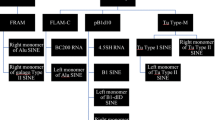Abstract
A model explaining properties exhibited by fragile-X DNA systems arises from observations that time-dependent base substitutions are expressed at G-C sites but not at A–T sites (Biochem. Genet.32:383, 1994). [CGG]n sequences are classified as most sensitive to evolutionary base substitution processes involving time-dependent populating of G-C sites with enol-imine states having enhanced stability. Increased density of these states in oocyte DNA would introduce a ground-state collapse double-helix of reduced energy that would inhibit strand separation by the replicase. Evolutionarily altered G′ in CG′G triplets allows CG′G to be transcribed as CTG, an initiation codon. And this will cause reinitiation of DNA synthesis, thereby adding additional CGG units to the collapsed double helix. This situation would not occur in slower-evolving male haploid DNA that replicates frequently.
Similar content being viewed by others
References
Baltz, R. H., Bingham, P. M., and Drake, J. W. (1976). Heat mutagenesis in bacteriophage T4: The transition pathway.Proc. Natl. Acad. Sci. USA 731269.
Bingham, P. M., Baltz, R. H., Ripley, L. S., and Drake, J. W. (1976). Heat mutagenesis in bacteriophage T4: The transversion pathway.Proc. Natl. Acad. Sci. USA 734159.
Caskey, C. T., Pizzuti, A., Fu, Y. H., Fenwick, R. G., and Nelson, D. L. (1992). Triplet repeat mutations in human diseases.Science 256784.
Chi, S. G., White, R. W., Meyers, F. J.,et al. (1994). P53 in prostate cancer: Frequent expressed transition mutations.J. Natl. Cancer Inst. 86926.
Cooper, W. G. (1993). Roles of evolution, quantum mechanics and point mutations in origins of cancer.Cancer Biochem. Biophys. 13147.
Cooper, W. G. (1994). T4 phage evolution data in terms of a time-dependent Topal-Fresco mechanism.Biochem. Genet. 32383.
Cooper, W. G. (1995a). Consequences of quantum mechanical proton bonds in duplex G-C DNA (submitted for publication).
Cooper, W. G. (1995b). Mechanism governing “gene pool” mutation levels as a consequence of time-dependent instability of DNA genetic specificity (submitted for publication).
Cooper, W. G. (1995c). Hypothesis on a causal link between EMF and an evolutionary class of cancer and spontaneous abortion (submitted for publication).
Cooper, W. G. (1995d). Role of evolutionary processes in origins of triplet repeat dynamic mutations (submitted for publication).
Darnell, J. E., and Doolittle, W. F. (1986). Speculations on the early course of evolution.Proc. Natl. Acad. Sci. USA 831271.
Dhar, R., Nieto, A., Koller, R., DeFeo-Jones, D., Roberson, P., Temeles, G., and Scolnick, E. M. (1984). Nucleotide sequence of two H-ras-related genes isolated from the yeastSaccharomyces cerevisiae.Nucleic Acid Res. 123611.
Drake, J. W., and McGuire, J. (1967). Characteristics of mutations appearing spontaneously in extracellular particles of bacteriophage T4.Genetics 55387.
Ehrenberg, L., von Ehrenstein, G., and Hedgran, A. (1957). Gonad temperature and spontaneous mutation rate in man.Nature 1801433.
Fu, Y. H., Kuhl, D. P. A., Pizzuti, A.,et al. (1991). Variation of the CGG repeat at the fragile-X site results in genetic instability: Resolution of the Sherman paradox.Cell 671047.
Gusella, J. F., MacDonald, M. E., Ambrose, C. M., and Duyao, M. P. (1993). Molecular genetics of Huntington's disease.Arch. Neurol. 501157.
Harris, A. L. (1991). Telling changes of base.Nature 350377.
Hsu, I. C., Metcalf, R. A., Sun, T., Welah, J. A., Wang, N. J., and Harris, C. C. (1991). Mutational hotspot in the p53 gene in human hepatocellular carcinomas.Nature 350427.
Jansen, G., Mahadevan, M., Amemiya, C.,et al. (1992). Characterization of the myotonic dystrophy region predicts multiple protein isoform-encoding mRNAs.Nature Genet. 1261.
Kataoka, T., Powers, S., Cameron, S., Fasano, O., Goldfarb, M., Broach, J., and Wigler, M. (1985). Functional homology of mammalian and yeastRAS genes.Cell 4019.
Kern, S. E., Pietenpol, J. A., Thiagalingam, S.,et al. (1992). Oncogenic forms of p53 inhibit p53-regulated gene expression.Science 256827.
Kricker, M., and Drake, J. W. (1990). Heat mutagenesis in bacteriophage T4: Another walk down the transversion pathway.J. Bact. 1723037.
La Spada, A., Wilson, E., Lubahn, D., Harding, A. and Fischbeck, K. (1991). Androgen receptor gene mutations in X-linked spinal and bulbar muscular atrophy.Nature 35277.
Orr, H. T., Chung, M. Y., Banfi, S.,et al. (1993). Expansion of an unstable trinucleotide CAG repeat in spinocerebellar ataxia type 1.Nature Genet. 4221.
Pizzuti, A., Friedman, D. L., and Caskey, C. T. (1993). The myotonic dystrophy gene.Arch. Neurol. 501173.
Rennie, J. (1993). DNA's new twist.Sci. Am. 266122.
Richards, R. I., and Sutherland, G. R. (1992). Fragile-X syndrome: The molecular picture comes into focus.Trends Genet. 8249.
Rosenberg, R. N. (1992). Amplification signals anticipation: less DNA is better.Neurology 421857.
Rosenberg, R. N. (1993). An introduction to the molecular genetics of neurological disease.Arch. Neurol. 501123.
Snowdon, D. A., Kane, R. L., Beeson, W. L.,et al. (1989). Is early natural menopause a biologic marker of health and aging?Am. J. Public Health 79709.
Topal, M. D., and Fresco, J. R. (1976). Complementary base pairing and the origin of substitution mutations.Nature 263285.
Verkerk, A. J., Pieretti, M., Sutcliffe, J.,et al. (1991). Identification of a gene (FMR-1) containing a CGG repeat coincident with a breakpoint cluster region exhibiting length variation in fragile-X syndrome.Cell 65905.
Watson, J. D., Hopkins, N. H., Roberts, J. W., Steitz, J. A., and Weiner, A. M. (1987).Molecular Biology of the Gene 4th ed., Benjamin/Cummings, Menlo Park, CA.
Author information
Authors and Affiliations
Rights and permissions
About this article
Cite this article
Cooper, W.G. Evolutionary origin of expandable G-C-rich triplet repeat DNA sequences. Biochem Genet 33, 173–181 (1995). https://doi.org/10.1007/BF00554729
Received:
Revised:
Issue Date:
DOI: https://doi.org/10.1007/BF00554729




